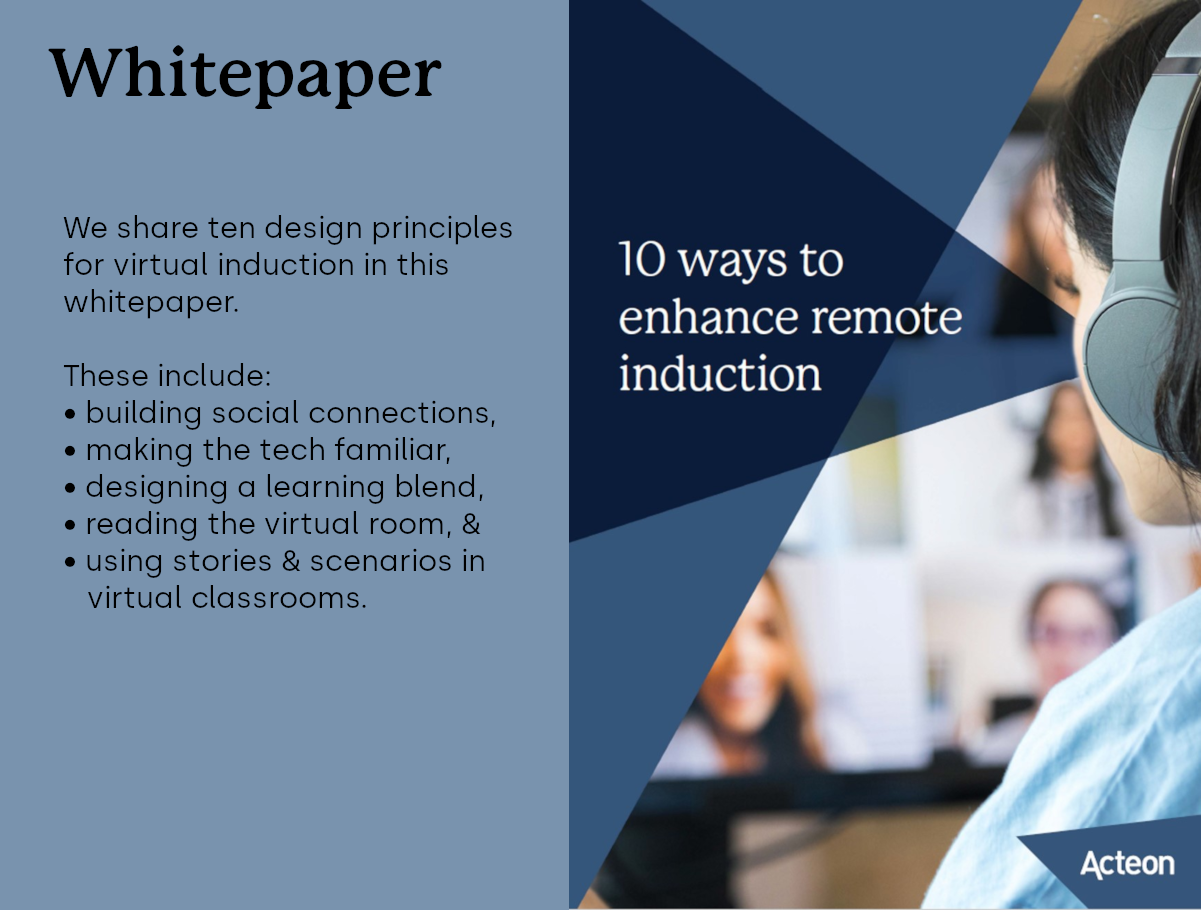As we move into the world of remote delivery for new starter inductions, our new whitepaper outlines ten principles that we should consider when designing virtual classrooms as part of onboarding.
The last three years have seen a rapid learning curve in what it takes to deliver brilliant online induction programmes for groups of new starters. Now HR and L&D leaders are assessing what has worked well, and reviewing online elements so they are designed and built virtual-first.
Sometimes this is needed just for elements of onboarding, or sometimes a whole programme for a cohort of new joiners.
The happy upsides of virtual
Companies we’ve worked with have been reporting several advantages of using more online delivery.
Often new employees are starting their roles at the same time but in different locations, and using virtual elements gives and easy way to join them together without the inconvenience and cost of travel. Advantages can also include inductees reaching competence faster, lower carbon footprint, more flexibility, less time away from work, and less demand on delivery teams.
Ingredients for successful delivery
There are some clear themes emerging around best practice for successful remote onboarding. The three ingredients explained below are critical: keeping it human, using time together in the most valuable way, and empowering trainers.
1. Keeping it human
Any virtual delivery needs to be designed for humans! It’s essential to understand how to foster a human-centric, warm environment online, and build social connection around the learning.
This includes:
- How are new starters feeling? What do they need to know in advance to manage expectations?
- Reaching out and making sure everyone feels included and heard in the virtual environment. Allowing space for interaction, and building psychological safety. Setting the right tone enables this. And the appropriate balance of interactivities, such as small group interactions, builds confidence among participants.
- Give inductees ways to connect with each other beyond the virtual classroom – such as chat groups etc.
- Being relatable. Use stories and scenarios to bring it to life and ground in real human experiences.
2. Using time together in the most valuable way
Bringing people together at the same time is an effort and an investment. That time is incredibly valuable. So it’s best used for interaction rather than information-giving.
Building a learning blend around the virtual classroom is a well-established approach. Well designed learning activities can be the main way to provide new information and test knowledge, and then the classroom time allows for questions, discussion and exploration of concepts. The blend might also include specific activities before or after the virtual classroom.
3. Empowering the trainers
Training facilitators were forced to make a rapid transition to virtual during the pandemic, often quickly repurposing their course materials. And many had to learn how to use platforms fast, and get comfortable with online delivery.
But now the focus is on helping them bring out their existing expertise in a new way. Virtual-first. Supporting them to really getting comfortable and feeling empowered to deliver excellent training.
Some principles include:
- Reassessing length and detail. It’s important for virtual classroom sessions to be designed for optimal learning online, which often means shorter sessions than in-person. Trainers need to be given confidence that this is reflected in adjusted expectations for how much detail is covered in the virtual classroom. Keep things sharp, snappy and memorable!
- Experiment. Using tools such as Miro, Padlet, Mural for activities can help facilitators with better interactions. And if they feel empowered to experiment, it gives confidence to try out things that might not work first time.
Whitepaper: 10 ways to enhance remote induction
In our new whitepaper, we share ten ways to make your virtual induction programme a stand-out success. Most of these tips and tactics are transferrable across all types of virtual classroom delivery, so are handy whatever programme you’re planning.
Download your copy

